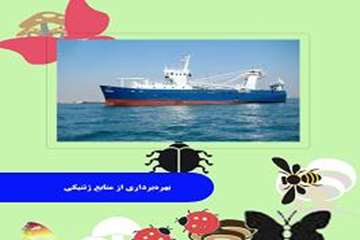Holding a socio-economic meeting on fisheries in Iranian Fisheries Science Research Institute
Holding a socio-economic meeting on fisheries in Iranian Fisheries
Science Research Institute
Socio-economic
meeting of fisheries, focusing on the economic and social challenges of fish
farming in cages, was held virtually on Monday, September 6, 2021.
According to the public relations
office of Iranian Fisheries Science Research Institute (IFSRI), a
socio-economic meeting about fisheries focusing on fish farming in cages and
attended by the head, deputies and managers of IFSRI, deputies and executors of
fish farming in cages of Iran Fisheries Organization, Head of Economic Affairs
of Agricultural Research, Education and Extension, experts, trustees and
representatives of the private sector, was held virtually.
In this meeting, Dr. Feyzbakhsh
presented an analytical report on Aquatic Economy and Market Questionnaire and
said: "Aquatic stocks are part of renewable natural resources that are
sustainable and have a great impact on human food supply. However, the real
average price of fish has fallen in recent years. "
He explained the economic issues in
the field of aquaculture and fishing, and finally explained the objectives of
preparing an analytical and research questionnaire.
Mr. Nayeri, CEO of Caspian Zhik
Sanat, spoke about the opportunities and challenges of aquaculture from a
socio-economic perspective. He said that the sustainability of natural
resources depends on an effective relationship among the three areas of social,
economic and environmental, and added that a balance must be struck between these
three sectors.
After announcing the statistics of
the number of employees in the world in fishing and aquaculture, he described
the employment and income of this field and continued: “out of about 60 million
people, one third is engaged in breeding activities and two thirds also work in
the fishing sector. The statistics is changing in favor of the breeding sector.
14% of them are women.
Lack of infrastructure, hardware and
software shortages were among the other important issues that Mr. Nayeri
mentioned.
Mr. Yousefi, CEO of the largest cage
fish breeding complex in the south of the country (Niksa), appreciating Dr.
Bahmani for pursuing the issue of cage fish farming and aligning research
institutes and southern centers for effective research in this field, said: It
seems that in these meetings, the presence of a representative of the
veterinary organization is also necessary to improve the work process.
"Fortunately, the position of
sea bass fish in the market is booming," he said, noting that the cage fish
farming industry could be a breakthrough in the fisheries sector. Therefore,
the platform provided for the development and even the export of this fish has
created a good opportunity that such meetings can clear the way for everyone.
Dr. Hosseinzadeh, Deputy Director of
Extension and Transfer of Findings of the Fisheries Science Research Institute,
said that although fisheries researchers have been able to achieve significant
achievements so far, there are still challenges that those in charge can resolve
with determination. He believes that a coherent plan in the socio-economic
fields of the cage should be developed and in this direction the role of
research and promotion in the field should be seen in a prominent way.
Mr. Izadi, from Fisheries Organization
of Iran, after presenting a report on the challenges and the current situation
in aquaculture production, said that one of the most important methods of
aquaculture is fish farming in sea cages.
He said: "In this industry, so
far we have had 480,000 tons of public requests to start activities and for
175,000 tons of fish, establishment licenses have been issued. Meanwhile, the
amount of production in 2020 is less than 13 thousand tons. "
Technological needs, solutions to
socio-economic challenges, and the importance of incentive policies to drive
local communities toward sustainable aquaculture were other important points
that Mr. Izadi described. He added: "Among the strategies for developing
cage fish farming is to produce juvenile fish in the country, provide
facilities, eliminate cumbersome laws, breeding and domesticate native species
such as Fourfinger threadfin and Red mouth grouper and create a system for
selling farmed fish." Dr. Taghavi suggested that the cultivation of
seafood and oysters, along with fish farming in cages, to be on the agenda.
At the end, the participants gave
their comments and suggestions.
http://english.ifsri.ir/news/view-54674.aspx






